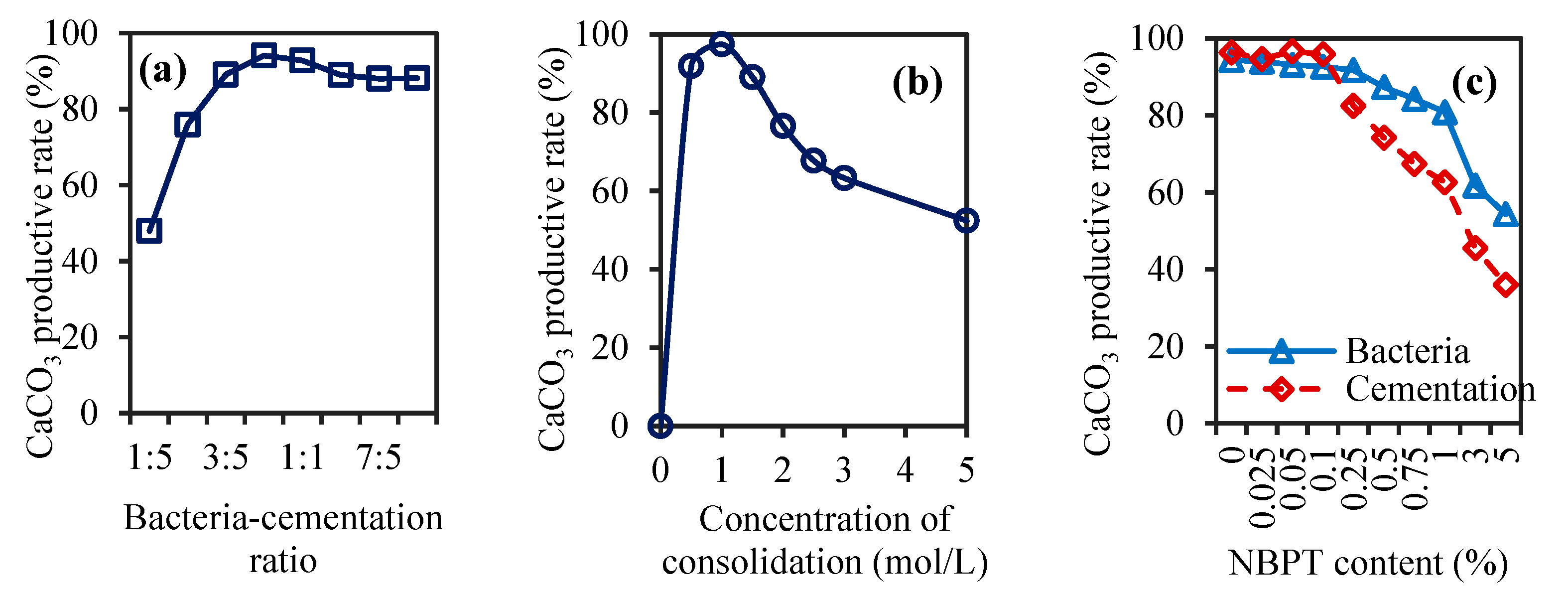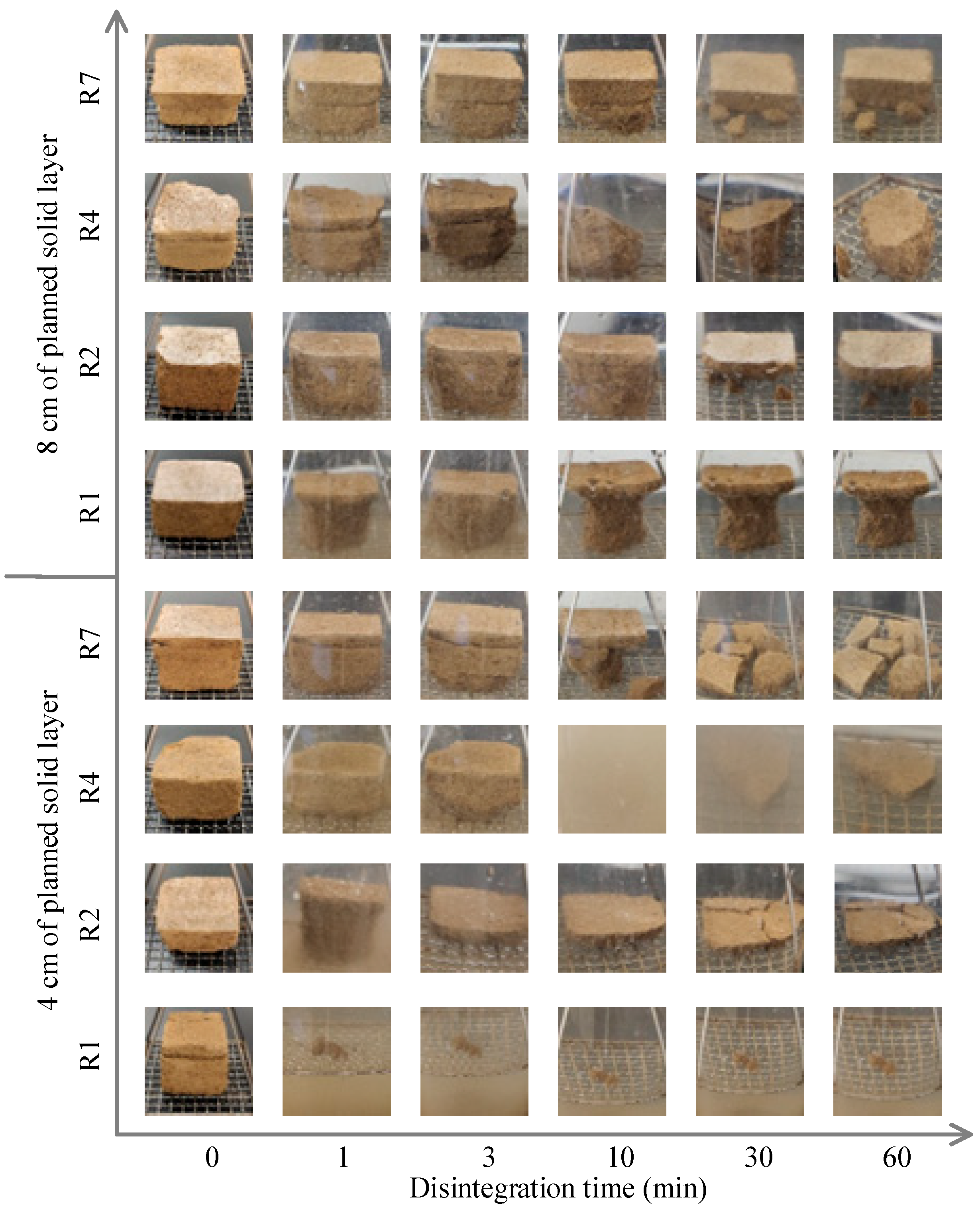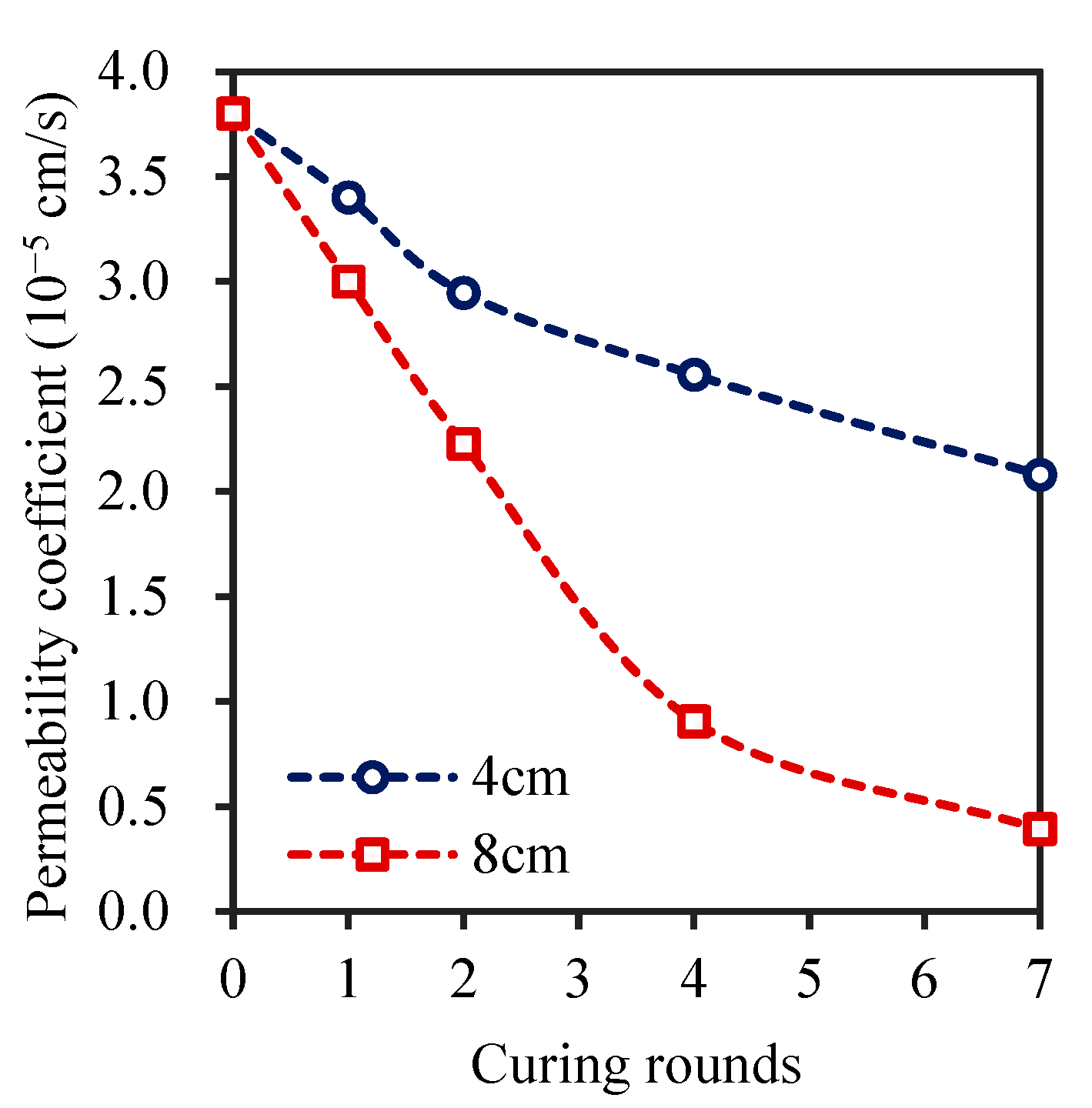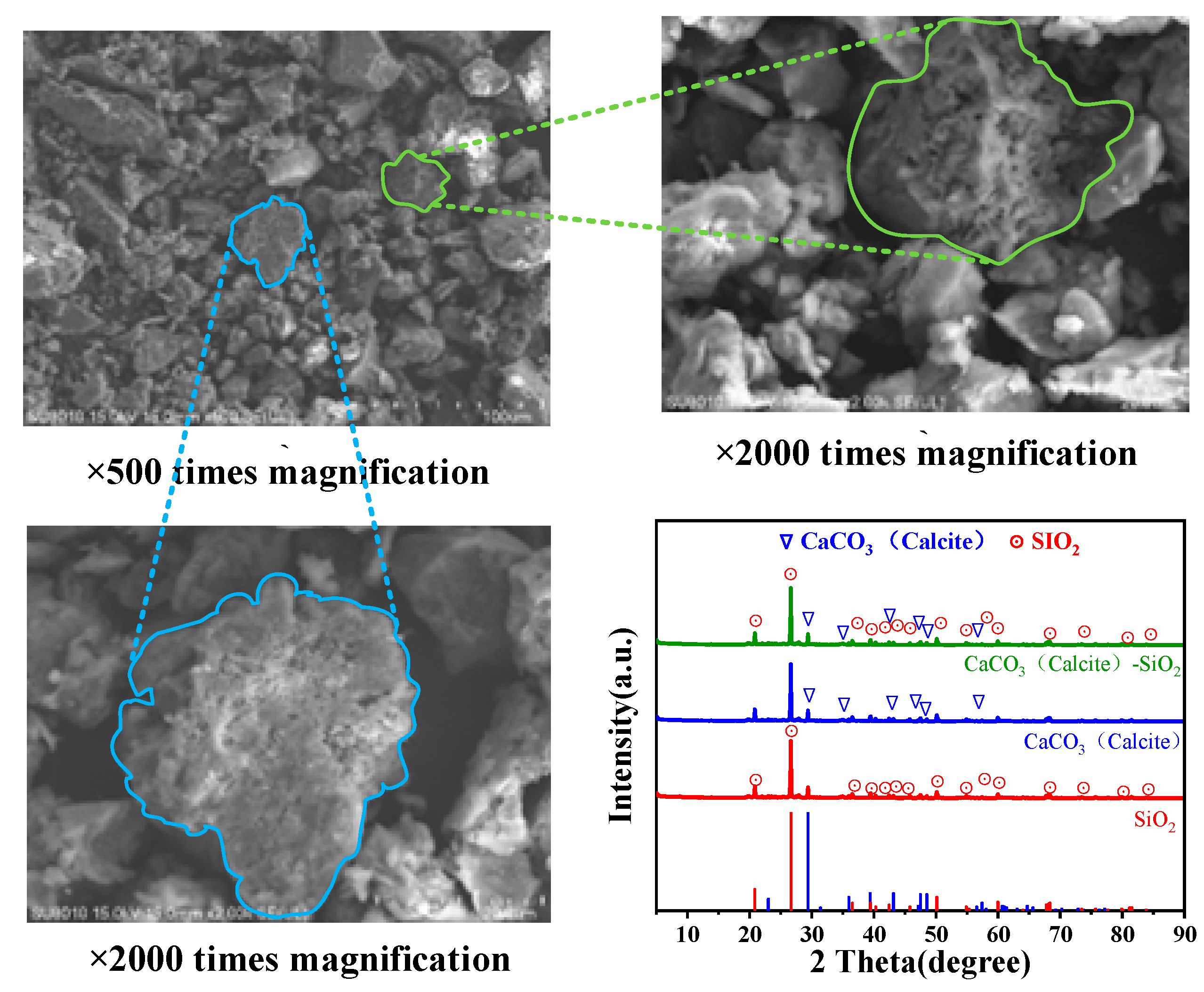Exploration of Microbially Induced Carbonate Precipitation Technology for the Protection of Soil on Agricultural Drainage Ditch Slopes
Abstract
1. Introduction
2. Materials and Methods
2.1. Materials
2.1.1. Liquid Materials
2.1.2. Soil Materials
2.2. Testing Methods
2.2.1. Liquid Tests for the Determination of Reagent Formulations
Bacteria–Cementation Ratio
Cementation Solution Concentration
Urease Inhibitor Carrier Solvent and Urease Inhibitor Content
2.2.2. Soil Tests for the Determination of Planned Solid Layer Thickness and Number of Curing Cycles
Test Design
Sample Selection and Measurement
2.2.3. Statistical Analysis
3. Results
3.1. Effect of Reagent Formula on CaCO3 Precipitation
3.1.1. Effect of Bacteria-Cementation Ratio on CaCO3 Yield
3.1.2. Effects of Cementation Solution Concentration on CaCO3 Yield
3.1.3. Effects of NBPT on CaCO3 Yield
3.2. Effects of Planned Solid Layer Thickness and Number of Curing Cycles on Soil Water Content and CaCO3 Precipitation
3.2.1. Soil Water Content
3.2.2. CaCO3 Content in Different Soil Layers
3.3. Effects of Planned Solid Layer Thickness and Number of Curing Cycles on Soil Mechanical Properties
3.3.1. Soil Penetration Resistance
3.3.2. Soil Disintegration
Disintegration Ratio
Disintegration Characteristics
3.3.3. Soil Permeability Coefficient
3.4. Effects of Planned Solid Layer Thickness and Number of Curing Cycles on Surface Soil Cracks
3.5. Effects of Planned Solid Layer Thickness and Number of Curing Cycles on Soil Microstructure
3.6. Limitations of This Study and Future Prospects
4. Conclusions
Author Contributions
Funding
Data Availability Statement
Acknowledgments
Conflicts of Interest
References
- Guo, G.; Galen, D.; Khan, I.; Sunohara, M.; Craiovan, E.; Chen, W. Examining the impact of agricultural drainage ditch management on in-stream bacterial communities involved in nitrogen cycling: Insights from the Environmental Change One Health Observatory (ECO2). Front. Sustain. Food Syst. 2024, 8, 1329422. [Google Scholar] [CrossRef]
- Yan, J.; Xing, Y.; Shi, H.; Li, X.; Ma, X. Review of research on farmland drainage ditches, weed control, slope protection, and ecological purification. Water Sav. Irrig. 2024, 10, 77–85. [Google Scholar]
- Ma, Y.; Bao, H.; Yan, C.; Lan, H.; Peng, J.; Zheng, H.; Song, Z.; Liu, C. Mechanical properties and microstructure evolution of two ecological slope-protection materials under dry-wet cycles. J. Clean. Prod. 2023, 416, 137833. [Google Scholar] [CrossRef]
- Habert, G.; Miller, S.; John, V.; Provis, J.; Favier, A.; Horvath, A.; Scrivener, K. Environmental impacts and decarbonization strategies in the cement and concrete industries. Nat. Rev. Earth Environ. 2020, 1, 559–573. [Google Scholar] [CrossRef]
- Aswad, A.; Yilmaz, M.; Ismail, S. A Systematic review study on different kinds of interlocking concrete blocks designs and properties. Turk. J. Eng. 2022, 6, 327–337. [Google Scholar] [CrossRef]
- Li, Y.; Lu, X.; Liu, S.; Li, L.; Bu, C.; Magombana, B.; Li, J. The progress and trend of Microbially Induced Carbonate Precipitation (MICP) research: A bibliometric analysis. Environ. Earth Sci. 2023, 82, 567. [Google Scholar] [CrossRef]
- Zhang, X.; Wang, H.; Wang, Y.; Wang, J.; Cao, J.; Zhang, G. Improved methods, properties, applications and prospects of microbial induced carbonate precipitation (MICP) treated soil: A review. Biogeotechnics 2024, 3, 100123. [Google Scholar] [CrossRef]
- Sreekala, A.; Nair, S.; Nathan, V. Microbially induced calcium carbonate precipitation using Lysinibacillus sp.: A ureolytic bacterium from uttarakhand for soil stabilization. Curr. Microbiol. 2024, 81, 387. [Google Scholar] [CrossRef]
- Punnoi, B.; Arpajirakul, S.; Pungrasmi, W.; Chompoorat, T.; Likitlersuang, S. Use of microbially induced calcite precipitation for soil improvement in compacted Clays. Int. J. Geosynth. Ground Eng. 2021, 7, 86. [Google Scholar] [CrossRef]
- Behzadipour, H.; Sadrekarimi, A. Effects of microbially induced calcite precipitation on static liquefaction behavior of a gold tailings sand. Biogeotechnics 2024, 2, 100097. [Google Scholar] [CrossRef]
- Fouladi, A.S.; Arulrajah, A.; Chu, J.; Horpibulsuk, S. Application of Microbially Induced Calcite Precipitation (MICP) technology in construction materials: A comprehensive review of waste stream contributions. Constr. Build. Mater. 2023, 388, 131546. [Google Scholar] [CrossRef]
- Liu, B.; Tang, C.; Pan, X.; Cheng, Q.; Shen, Z.; Xu, J.; Zhang, X. Influence of layer thickness on bioremediation of drought-induced soil desiccation cracks using microbially induced calcite precipitation. Acta Geotech. 2024, 19, 4399–4414. [Google Scholar] [CrossRef]
- Zhang, Y.; Liu, Y.; Sun, X.; Zeng, W.; Xing, H.; Lin, J.; Kang, S.; Yu, L. Application of microbially induced calcium carbonate precipitation (MICP) technique in concrete crack repair: A review. Constr. Build. Mater. 2024, 411, 134313. [Google Scholar] [CrossRef]
- Dagliya, M.; Satyam, N.; Garg, A. Optimization of growth medium for microbially induced calcium carbonate precipitation (MICP) treatment of desert sand. J. Arid Land 2023, 15, 797–811. [Google Scholar] [CrossRef]
- Bu, C.; Lu, X.; Zhu, D.; Liu, L.; Sun, Y.; Wu, Q.; Zhang, W.; Wei, Q. Soil improvement by microbially induced calcite precipitation (MICP): A review about mineralization mechanism, factors, and soil properties. Arab. J. Geosci. 2022, 15, 863. [Google Scholar] [CrossRef]
- Raveh-Amit, H.; Gruber, A.; Abramov, K.; Tsesarsky, M. Mitigation of aeolian erosion of loess soil by Bio-Stimulated microbial induced calcite precipitation. Catena 2024, 237, 107808. [Google Scholar] [CrossRef]
- Wang, Y.; Sun, X.; Miao, L.; Wang, H.; Wu, L.; Shi, W.; Kawasaki, S. State-of-the-art review of soil erosion control by MICP and EICP techniques: Problems, applications, and prospects. Sci. Total Environ. 2024, 912, 169016. [Google Scholar] [CrossRef]
- Wang, R.; Tang, C.; Pan, X.; Shen, Z.; Liu, Y.; Lu, X. A biotechnological approach for suspended solids removal in biogas slurry via microbially induced calcite precipitation (MICP). J. Clean. Prod. 2024, 459, 142537. [Google Scholar] [CrossRef]
- Liu, Y.; Ali, A.; Su, J.; Li, K.; Hu, R.; Wang, Z. Microbial-induced calcium carbonate precipitation: Influencing factors, nucleation pathways, and application in waste water remediation. Sci. Total Environ. 2023, 860, 160439. [Google Scholar] [CrossRef]
- Khoshtinat, S. Advancements in exploiting sporosarcina pasteurii as sustainable construction material: A review. Sustainability 2023, 15, 13869. [Google Scholar] [CrossRef]
- Zúñiga-Barra, H.; Toledo-Alarcón, J.; Torres-Aravena, Á.; Jorquera, L.; Rivas, M.; Gutiérrez, L.; Jeison, D. Improving the sustainable management of mining tailings through microbially induced calcite precipitation: A review. Miner. Eng. 2022, 189, 107855. [Google Scholar] [CrossRef]
- Fu, T.; Saracho, A.C.; Haigh, S.K. Microbially induced carbonate precipitation (MICP) for soil strengthening: A comprehensive review. Biogeotechnics 2023, 1, 100002. [Google Scholar] [CrossRef]
- Chen, Y.; Han, Y.; Zhang, X.; Sarajpoor, S.; Zhang, S.; Yao, X. Experimental study on permeability and strength characteristics of MICP-treated calcareous sand. Biogeotechnics 2023, 1, 100034. [Google Scholar] [CrossRef]
- Prajapati, N.; Agnihotri, A.; Basak, N. Microbial induced calcite precipitation (MICP) a sustainable technique for stabilization of soil: A review. Mater. Today Proc. 2023, 93, 357–361. [Google Scholar] [CrossRef]
- Cheng, L.; Shahin, M. Chapter 3: Microbially induced calcite precipitation (MICP) for soil stabilization: Innovative approaches to socio-ecological sustainability. In Ecological Wisdom Inspired Restoration Engineering; Springer: Singapore, 2019; pp. 47–68. [Google Scholar]
- Rahmaninezhad, S.; Houshmand, M.; Sadighi, A.; Ahmari, K.; Kamireddi, D.; Street, R.M.; Farnam, Y.A.; Schauer, C.L.; Najafi, A.R.; Sales, C.M. Overcoming the inhibitory effects of urea to improve the kinetics of microbial-induced calcium carbonate precipitation (MICP) by Lysinibacillus sphaericus strain MB284. J. Biosci. Bioeng. 2024, 138, 63–72. [Google Scholar] [CrossRef]
- Saracho, A.; Haigh, S.; Hata, T.; Soga, K.; Farsang, S.; Redfern, S.; Marek, E. Characterization of CaCO3 phases during strain-specific ureolytic precipitation. Sci. Rep. 2020, 10, 10168. [Google Scholar]
- Zehner, J.; Røyne, A.; Sikorski, P. Sample cell for the study of enzyme-induced carbonate precipitation at the grain-scale and its implications for biocementation. Sci. Rep. 2021, 11, 13675. [Google Scholar] [CrossRef]
- Xu, W.; Zheng, J.; Chu, J.; Zhang, R.; Cui, M.; Lai, H.; Zeng, C. New method for using N-(N-butyl)-triphosphoric triamide to improve the effect of microbial induced carbonate precipitation. Constr. Build. Mater. 2021, 313, 125490. [Google Scholar] [CrossRef]
- Cantarella, H.; Otto, R.; Soares Johnny, R.; Silva, A. Agronomic efficiency of NBPT as a urease inhibitor: A review. J. Adv. Res. 2018, 13, 19–27. [Google Scholar] [CrossRef]
- Bhadiyadra, K.; Jong, S.; Ong, D.; Doh, J. Trends and opportunities for greener and more efficient microbially induced calcite precipitation pathways: A strategic review. Geotech. Res. 2024, 11, 161–185. [Google Scholar] [CrossRef]
- Sigurdarson, J.; Svane, S.; Karring, H. The molecular processes of urea hydrolysis in relation to ammonia emissions from agriculture. Rev. Environ. Sci. Biotechnol. 2018, 17, 241–258. [Google Scholar] [CrossRef]
- Liu, Q.; Jin, X.; Fang, F.; Li, J.; Du, G.; Kang, Z. Food-grade expression of an iron-containing acid urease in Bacillus subtilis. J. Biotechnol. 2019, 293, 66–71. [Google Scholar] [CrossRef]
- da Fonseca, A.; Santos, C.; Nunes, A.; Oliveira, D.; de Melo, M.; Takayama, T.; Mansur, B.; de Jesus, F.; do Carmo, A.; Dias, M.; et al. Urease inhibitors technologies as strategy to mitigate agricultural ammonia emissions and enhance the use efficiency of urea-based fertilizers. Sci. Rep. 2023, 13, 22739. [Google Scholar] [CrossRef]
- Seifan, M.; Berenjian, A. Microbially induced calcium carbonate precipitation: A widespread phenomenon in the biological world. Appl. Microbiol. Biotechnol. 2019, 103, 4693–4708. [Google Scholar] [CrossRef] [PubMed]
- Salehi Sarvak, A.H.; Almodaresi, S.A.; Deh-abadi, A.M.; Shishehbore, M.R.; Kangazian, A.H.; Jamali, A.A. Calcium carbonate sediment corrosion and formation investigation in drinking water distribution network in Sough City, Iran. Sci. Rep. 2025, 15, 2548. [Google Scholar] [CrossRef]
- Zhou, H.; Li, H. Soil Disintegration characteristics of collapsed walls and influencing factors in southern China. Open Geosci. 2018, 10, 797–806. [Google Scholar] [CrossRef]
- Gilmour, K.; Ghimire, P.; Wright, J.; Haystead, J.; Dade-Robertson, M.; Zhang, M.; James, P. Microbially induced calcium carbonate precipitation through CO2 sequestration via an engineered Bacillus subtilis. Microb. Cell Factories 2024, 23, 168. [Google Scholar] [CrossRef] [PubMed]
- Whiffin, V.; van Paassen, L.; Harkes, M. Microbial carbonate precipitation as a soil improvement technique. Geomicrobiol. J. 2007, 24, 417–423. [Google Scholar] [CrossRef]
- Yi, H.; Zheng, T.; Jia, Z.; Su, T.; Wang, C. Study on the influencing factors and mechanism of calcium carbonate precipitation induced by urease bacteria. J. Cryst. Growth 2021, 564, 126113. [Google Scholar] [CrossRef]
- Wang, H.; Miao, L.; Sun, X.; Wu, L.; Fan, G.; Zhang, J. The use of N-(N-butyl)-thiophosphoric triamide to improve the efficiency of enzyme induced carbonate precipitation at high temperature. Acta Geotech. 2023, 18, 5063–5081. [Google Scholar] [CrossRef]
- Liu, B.; Tang, C.; Pan, X.; Zhu, C.; Cheng, Y.; Xu, J.; Shi, B. Potential drought mitigation through microbial induced calcite precipitation-MICP. Water Resour. Res. 2021, 57, e2020WR029434. [Google Scholar] [CrossRef]
- Ezzat, S. A critical review of microbially induced carbonate precipitation for soil stabilization: The global experiences and future prospective. Pedosphere 2023, 33, 717–730. [Google Scholar] [CrossRef]
- Tan, H.; Chen, F.; He, J.; Chen, J. Effect of soil particle size on the rate of calcium carbonate deposition induced by microorganisms. J. Harbin Eng. Univ. 2019, 40, 1884–1889. [Google Scholar]
- Yuan, X.; Zhu, T.; Wang, Q.; Chen, H.; Lin, S.; Wang, X.; Xu, X. An experimental investigation of dispersive soils treated by microbially induced calcium carbonate precipitation (MICP). Constr. Build. Mater. 2024, 446, 137941. [Google Scholar] [CrossRef]
- Castellano, M.; Archontoulis, S.; Helmers, M.; Poffenbarger, H.; Six, J. Sustainable intensification of agricultural drainage. Nat. Sustain. 2019, 2, 914–921. [Google Scholar] [CrossRef]
- Carstensen, M.; Hashemi, F.; Hoffmann, C.; Zak, D.; Audet, J.; Kronvang, B. Efficiency of mitigation measures targeting nutrient losses from agricultural drainage systems: A review. Ambio: J. Hum. Environ. 2020, 49, 1820–1837. [Google Scholar] [CrossRef] [PubMed]
- Herzon, I.; Helenius, J. Agricultural drainage ditches, their biological importance and functioning. Biol. Conserv. 2008, 141, 1171–1183. [Google Scholar] [CrossRef]
- Kasirajan, S.; Parthipan, T.; Elamathy, S.; Senthil Kumar, G.; Rajavel, M.; Veeramani, P. Dynamics of soil penetration resistance, moisture depletion pattern and crop productivity determined by mechanized cultivation and lifesaving irrigation in zero till blackgram. Heliyon 2024, 10, e28625. [Google Scholar] [CrossRef]
- Li, K.; Wang, Y. The impact of Microbially Induced Calcite Precipitation (MICP) on sand internal erosion resistance: A microfluidic study. Transp. Geotech. 2024, 49, 101404. [Google Scholar] [CrossRef]
- Lv, J.; Bao, Y.; Yang, L.; He, X.; Zhang, H.; Li, H. Elevation-related variations of soil disintegration and its driving forces in the water level fluctuation zone of the Three Gorges Reservoir, China. Geomorphology 2024, 455, 109193. [Google Scholar] [CrossRef]
- Feng, D.; Yu, Y.; Wang, J.; Fang, C.; Liang, S. Experimental study on shear and disintegration resistance of MICP-treated residual granite soil. Environ. Earth Sci. 2024, 83, 179. [Google Scholar] [CrossRef]
- Arpajirakul, S.; Pungrasmi, W.; Likitlersuang, S. Efficiency of microbially-induced calcite precipitation in natural clays for ground improvement. Constr. Build. Mater. 2021, 282, 122722. [Google Scholar] [CrossRef]
- Xie, J.; Gao, J.; Cao, H.; Li, J.; Wang, X.; Zhang, J.; Meng, H.; Hong, J.; Li, T.; Xu, M. Calcium carbonate promotes the formation and stability of soil macroaggregates in mining areas of China. J. Integr. Agric. 2024, 23, 1034–1047. [Google Scholar] [CrossRef]
- Huo, B.; Huang, Q.; Kang, X.; Liu, X.; Liu, M.; Peng, J. Experimental study on the disintegration characteristics of undisturbed loess under rainfall-induced leaching. Catena 2023, 233, 107482. [Google Scholar] [CrossRef]
- Ji, X.; Tang, C.; Pan, X.; Cheng, Y.; Shi, B. Enhancing biocementation performance in low permeability clayey soil through sand column strategy. Catena 2024, 245, 108301. [Google Scholar] [CrossRef]
- Zhang, K.; Tang, C.; Jiang, N.; Pan, X.; Liu, B.; Wang, Y.; Shi, B. Microbial-induced carbonate precipitation (MICP) technology: A review on the fundamentals and engineering applications. Environ. Earth Sci. 2023, 82, 229. [Google Scholar] [CrossRef] [PubMed]
- Xie, J.; Tang, C.; Liu, B.; Chen, Q.; Yin, L.; Jiang, N.; Shi, B. Water stability improvement of clay based on microbial induced calcium carbonate deposition technology. Zhejiang Univ. Eng. Technol. 2019, 53, 10. [Google Scholar]
- Zhang, Y.; Yan, D.; Qu, J.; Wang, X.; Lei, Y.; Du, B.; Xue, K.; Li, G. Research progress of microbial-induced calcium carbonate deposition (MICP) solidified soils. Civ. Eng. 2019, 13, 603–612. [Google Scholar]
- Zúñiga-Barra, H.; Ostojic, C.; Torres-Aravena, Á.; Rivas, M.; Vílchez, C.; Jeison, D. Use of photosynthetic MICP to induce calcium carbonate precipitation: Prospecting the role of the microorganism in the formation of CaCO3 crystals. Algal Res. 2024, 80, 103499. [Google Scholar] [CrossRef]
- No. 05-0586; CaCO3 Standard Card of Calcite Crystal Form. International Joint Committee on Powder Diffraction Standards (JCPS): Philadelphia, PA, USA, 2006.







Disclaimer/Publisher’s Note: The statements, opinions and data contained in all publications are solely those of the individual author(s) and contributor(s) and not of MDPI and/or the editor(s). MDPI and/or the editor(s) disclaim responsibility for any injury to people or property resulting from any ideas, methods, instructions or products referred to in the content. |
© 2025 by the authors. Licensee MDPI, Basel, Switzerland. This article is an open access article distributed under the terms and conditions of the Creative Commons Attribution (CC BY) license (https://creativecommons.org/licenses/by/4.0/).
Share and Cite
Huang, X.; Li, J.; Su, M.; Jiao, X.; Wu, Q.; Gu, Z. Exploration of Microbially Induced Carbonate Precipitation Technology for the Protection of Soil on Agricultural Drainage Ditch Slopes. Water 2025, 17, 2010. https://doi.org/10.3390/w17132010
Huang X, Li J, Su M, Jiao X, Wu Q, Gu Z. Exploration of Microbially Induced Carbonate Precipitation Technology for the Protection of Soil on Agricultural Drainage Ditch Slopes. Water. 2025; 17(13):2010. https://doi.org/10.3390/w17132010
Chicago/Turabian StyleHuang, Xinran, Jiang Li, Mingxiao Su, Xiyun Jiao, Qiuming Wu, and Zhe Gu. 2025. "Exploration of Microbially Induced Carbonate Precipitation Technology for the Protection of Soil on Agricultural Drainage Ditch Slopes" Water 17, no. 13: 2010. https://doi.org/10.3390/w17132010
APA StyleHuang, X., Li, J., Su, M., Jiao, X., Wu, Q., & Gu, Z. (2025). Exploration of Microbially Induced Carbonate Precipitation Technology for the Protection of Soil on Agricultural Drainage Ditch Slopes. Water, 17(13), 2010. https://doi.org/10.3390/w17132010







